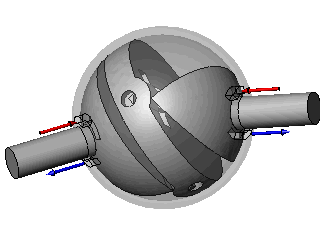http://cvcoupling.com/index.php?option=com_content&task=view&id=37&Itemid=41



PPE engine having transfer ports at the ends of its cylinders:
power is at least 20% wasted on the standard stock kind of coupling in all our cars. Check this video and make a request for purchase for those who want a what looks like a 50 BHP boost in their cars.
http://cvcoupling.co...id=37&Itemid=41
article below : (warning : quite lengthy article)
The Thompson Coupling is certainly amongst the most important inventions since the advent of the internal combustion engine. It is the world's first and only, practical, constant velocity joint to have no load bearing sliding surfaces.
Shaft couplings are essential to our mechanised era. Amazing as it may seem, although mankind has landed men on the moon and done so many other wondrous things he has not been capable of efficiently transmiting power from one shaft to another at constant velocity. This is an invention which has been actively sought for about 400 years when Sir Robert Hooke made the first known attempt to construct a constant velocity coupling.
- The Thompson Coupling is as essential to our mechanised age as the screw, the crank, the lever and piston
- The Thompson Coupling is the world's first and only Constant Velocity Joint which:
- Has all loads carried by roller bearings
- Has no sliding or skidding surfaces whatsoever
- Can tolerate axial and radial loads without degradation
- Has no torque limitation, constructed to any torque level
- Does not require special lubrication
- Does not require a dust boot
- No wearing components except replaceable bearings and trunnions
- Is suitable for automotive tail or propeller shaft applications
- Is a true Constant Velocity Coupling as distinct from a cv joint
- Is less bulky than a double coupling or double Cardan joint.
- The Thompson Coupling is essentially two Cardan joints assembled coaxially where the cruciform-equivalent members of each are connected to one another by trunnions and bearings which are constrained to continuously lie on the homokinetic plane of the joint.
The constraining means which constrains the said trunnions and bearings consists of a two segment spherical four bar linkage or spherical draglink. One end of the draglink is attached to a trunnion on an extension to the input shaft while the second end of the draglink is connected to a removable pin forming a trunnion on the inside of the yoke of the output shaft. Each arm or bar of the draglink continuously forms a great circle arc centered upon the axis of the joint. The central axis of the draglink is located on a trunnion in the middle of a "C" shaped member, the ends of the "C" shaped member are located on the extended trunnions which connect the two Cardan joints.
With operation of the joint, the central axis of the draglink and therefore the trunnion in the center of the "C" member, continuously bisects the included acute angle between the extended axis of the input and output shafts and therefore continuously lies on the axis of the homokinetic plane of the joint.
Consequently the axis of the trunnions which connect the inner and outer Cardan joints are constrained to continuously lie on the homokinetic plane of the joint. (Note:- The homokinetic plane is that plane which is perpendicular to the plane of the axis of the input and output shafts and which bisects the obtuse angle between the axis of the input and output shafts.)
As is well known, four bar linkage mechanisms are structurally excellent and this remains true in spherical form.
In operation the component parts of the coupling remain balanced about the three rotational axis of the joint namely the input shaft axis, the output shaft axis and the axis of the homokinetic plane.
In mass production each and every component of the Thompson Coupling can be produced by forging and/or casting with the only further requirement being to drill and machine the bearing journals, holes and circlip grooves.
No dedicated machinery is required and there is no complex machining at all.
Bearings for most applications are stock and assembly is very simple.
For one-off project applications, manufacture is simple and within the capability of any machine shop. No specialist machinery is required as is the case with Rzeppa type joints.
The Thompson Coupling has essentially the same construction as a normal Cardan joint but does not suffer the dynamic loads due to fluctuating angular velocity of intermediate shafts and load as is the case where Cardan joints are used.
As a result, the Thompson Coupling should have a life exceeding an ordinary Cardan joint. It stands to sense, and our testing will prove it. There is no untried technology in the Thompson Coupling. It is essentially identical to two Cardan joints in its torque transmission.
The components and the moving components in the constraining mechanism are tried and true roller bearings. There are no mysteries or unknowns.
A Thompson Coupling can be disassembled with a pair of circlip pliers and the bearings replaced with a minimum of expertise and downtime.
The Thompson Coupling is very compact and may be over-engineered to increase reliability without adding substantially to bulk and weight.
It is obvious that use of the Thompson Coupling in lieu of Cardan Joints will eliminate a large source of vibration in many machines and automotive applications.

No comments:
Post a Comment